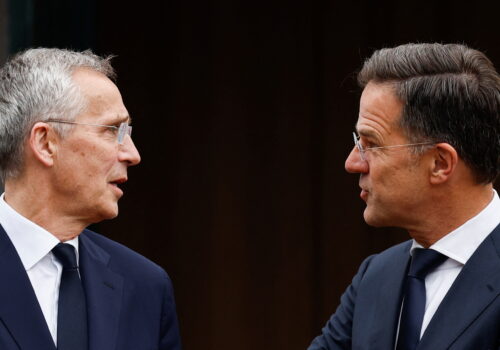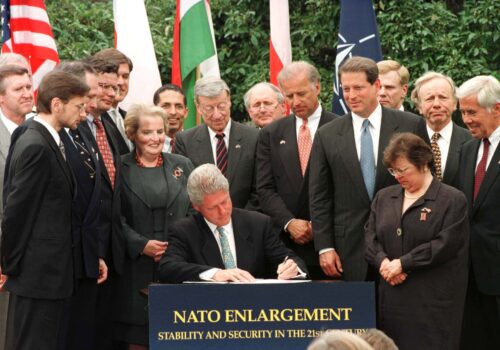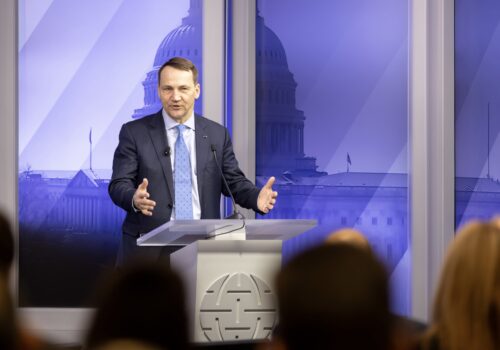NATO’s decision process has an Achilles’ heel
In Washington this July, the most successful political-military alliance in modern history will celebrate its seventy-fifth anniversary. NATO successfully deterred Soviet aggression for forty years during the Cold War and stanched the nasty Balkan wars that threatened Europe’s peace in the immediate aftermath of that “long, twilight struggle.” Now, the Alliance stands as a barrier to Russian President Vladimir Putin’s ambition to recreate a “Russian world,” bringing Russophone citizens back into something like the borders of the Soviet Union by reabsorbing Ukraine and possibly Moldova and the Baltic states. The Russian autocrat’s invasion of Ukraine has strengthened the Alliance by adding two very capable members (Finland and now, finally, Sweden), and by strengthening the will of member states to stand together against Russian aggression. It has also exposed some of the shortcomings of the US and European defense industrial bases, both of which require serious and urgent investment by all members of the Alliance to successfully and sustainably address their deficiencies.
The Alliance began with a manageable core group of twelve nations. But through nine separate rounds of expansion, it now includes previous Warsaw Pact members, which sought protection from their former occupier by moving under the Alliance’s nuclear umbrella. It has also welcomed former neutral and nonaligned states that see Russia’s current revanchism as an existential threat to their independence. These additional members have brought the Alliance to a membership of thirty-two states.
Under the terms of NATO’s founding document, the 1949 Washington Treaty, admission of new members to the Alliance is based on the unanimous consent of the existing members. This consensus principle has over time evolved into a norm governing how NATO makes decisions. As the NATO website notes: “Consensus decision-making is a fundamental principle. It has been accepted as the sole basis for decision-making in NATO since the creation of the Alliance in 1949.” The fact is, however, that the principle, except in the case of accession, is not enshrined or codified in any Alliance document. What worked for the Alliance earlier, when all of its members were like-minded states facing an overwhelming military challenge and the memories of World War II were fresh in the minds of both publics and leaders, may not be fit for purpose today with a broader and much more diverse membership. (While the possibility of Donald Trump returning to the White House has raised serious concerns about the transatlantic relationship and how NATO would operate without or with a diminished US role, that contingency is beyond the scope of this essay.)
This is not a purely hypothetical issue. The recent efforts of Turkish President Recep Tayyip Erdoğan and Hungarian Prime Minister Viktor Orbán to extract benefits for allowing the accession process for Finland and Sweden to move forward demonstrates how easily the consensus rule can be abused by a leader who believes that he or she can derive political advantage from doing so. There are precedents. Erdoğan tried to block the selection of Anders Fogh Rasmussen as NATO secretary general in 2009; and Orbán tried recently to block the European Union consensus on aid to Ukraine. In a similar vein, Slovak Prime Minister Robert Fico, who recently returned to power, made noises this past October about ending support for Ukraine, before reaffirming his support after a meeting with Ukrainian Prime Minister Denys Shmyhal, in Uzhgorod, Ukraine, in January. Nevertheless, Fico’s earlier comments raise concerns about the real strength of his commitment to Ukraine. As these examples show, NATO needs to find ways to diminish the scope for transactionalism within the Alliance at the cost of collective defense.
Consider the following scenario:
Late this decade, Russia sends several hundred “little green men” into a NATO country and positions major ground formations on that country’s border with Russia. The “little green men” seize control of a major city. Moscow demands a change of government, alleging that the existing government has pursued policies hostile to Russian-speaking citizens of said country. The NATO state refuses and invokes Article 5. At the NATO Council meeting, an Alliance member whose leader has close ties to the Russian president refuses to agree. Lacking a consensus, Article 5 cannot be adopted. The Alliance is paralyzed and fractured. The remaining NATO nations are left to try to organize a “coalition of the willing” to defend the threatened ally, but they cannot use NATO mechanisms or command arrangements to do so. Russia then sends major combat forces across the border . . .
While such a scenario is conjectural, it is not unrealistic. Indeed, in February 2003, Turkey’s request that NATO military authorities prepare plans to defend it against a potential Iraqi attack was blocked by three allies, a situation only resolved by deft diplomatic maneuvering by then Secretary General George Robertson.
The behavior and politics of Erdoğan and Orbán indicate that the time has come to revise the consensus model in critical Article 5 situations, particularly in light of the fact that Russia has withstood Western sanctions in better shape than many had anticipated. It has sought munitions and drones from North Korea and Iran and has reconstituted its domestic defense industry to a remarkable degree. Nearly 40 percent of the Russian government budget is now devoted to defense and law enforcement, and Russia will likely be able to replenish its losses in Ukraine more rapidly than many observers anticipated even a few months ago. Against that backdrop, it is no wonder that NATO military leaders have expressed their concern that Putin may attack one or more members of the Alliance within the next three to five years.
At the upcoming Washington summit, NATO members should therefore discuss how best to introduce a majority voting procedure. This would make it impossible for one member state to serve Russia’s interests by insisting on the consensus principle, thereby paralyzing the Alliance’s ability to defend an ally from Russian aggression. There are various ways of approaching the issue, and a variety of possible alternative solutions, some of which have already been explored.
Given the threatening international backdrop and the need to balance the cohesion of a larger Alliance with the ability to make rapid and resolute decisions, the time has come for the US administration and the UK government to foster a robust debate at the summit about such solutions. Allies need to decide how to eliminate the risk that, in a grave crisis, a spoiler state could prevent NATO from invoking Article 5. At stake is nothing less than the core Alliance commitment to collective defense.
Eric S. Edelman was US ambassador to Finland in the Clinton administration and to Turkey in the George W. Bush administration. He also served as undersecretary of defense for policy
David Manning is a retired British diplomat. Among his assignments, he was the British permanent representative (ambassador) to NATO.
Franklin C. Miller served for three decades as a senior nuclear policy and arms control official in the Pentagon and on the National Security Council staff.
Further reading
Thu, Mar 7, 2024
What kind of leader is required for the future of the NATO Alliance?
New Atlanticist By Timo S. Koster
Dutch Prime Minister Mark Rutte is the clear front-runner to be the next secretary general, but his candidacy is not quite assured.
Wed, Mar 6, 2024
NATO enlargement at twenty-five: How we got there and what it achieved
New Atlanticist By
Two and a half decades after Poland, Hungary, and the Czech Republic joined NATO, their membership continues to protect them from Russian aggression.
Mon, Feb 26, 2024
Polish Foreign Minister Radosław Sikorski: ‘Helping Ukraine is not only a good deed. It’s also a good deal.’
New Atlanticist By
The United States must continue to back Ukraine and deepen its alliances to stop Putin's aggression and prevent a wider global conflict.
Image: Handout photo shows General View of the meeting Brussels, Belgium, November 28, 2023. Photo by NATO via ABACAPRESS.COM


